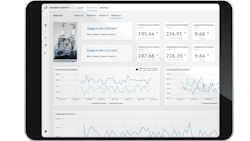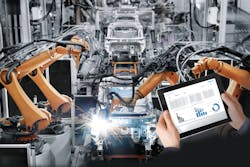How to Implement AI in Fluid Power Applications
Artificial Intelligence (AI) – the ability of machines to perceive, synthesize and infer information – can now be found in almost all sectors and applications, including fluid power due to increased digitalization of components and systems.
As described in a white paper from the organizers of the International Fluid Power Exposition (IFPE) 2023, digitalization enables or improves processes using digital technologies such as sensors and software. These enable the collection of performance data which can then be analyzed via AI.
Why implement AI in fluid power? Frank Latino, Global Product Manager, Electric Automation at Festo Americas, said during a Power & Motion webinar on the benefits of AI in fluid power that doing so can help customers improve their businesses.
He said three of the key benefits associated with deploying AI in fluid power applications are:
- improving maintenance processes,
- increasing product quality and
- lowering energy consumption.
“It is not just AI technology that is needed for this,” said Latino. “We are leveraging technologies in addition to AI that include the Internet of Things and edge computing. There are also different software tools…and the combination of all of this together would provide these benefits.”
As part of the webinar, Power & Motion conducted a Q&A with Latino to learn more about how best to implement AI in fluid power.
*Editor’s Note: Questions and responses have been edited for clarity.
Power & Motion (P&M): What are the first key steps one should take if looking to implement or make use of AI and its related technologies?
Frank Latino (FL): One of the very first steps that you need to take is to get a really good understanding of what your pain point is and taking a look at what kind of data you think might be available to solve that pain point.
It might be good to [also] get some consultation in that area. People who are really familiar [and] work with this on a regular basis have a way of looking at certain sensors and devices, figuring out what information needs to be added to [a] system [and] taking the existing information and transforming it in a way where it is useful to solve a particular pain point.
And with that, having a good understanding of the ROI (return on investment) would be very important at that early stage; what return on investment would you get for this tool?
P&M: What are some of the challenges associated with implementing AI and related technologies? And how can these be overcome?
FL: Implementing any of these solutions is not a one size fits all kind of thing. So, understanding what kind of infrastructure you have and how you can get the right quality of data out of the system is important.
All customers have different ways of consuming this data. [They] may want to report anomalies into an ERP system or an MRP system, or maybe just want a dashboard that could help them find information. Every customer has something different it wants to achieve with this, and having an understanding of the data structure and where the data has to go tend to be some of the challenges.
Bringing someone with expertise into the mix can easily help customers overcome those challenges. You can always overcome [the challenges], but sometimes just need a second set of eyes to see how best to overcome them.
P&M: Do you see use of AI being applicable for any type of application or industry, or are there certain ones for which it is best suited?
FL: I think AI is suitable for most use cases. You are deploying a software tool into a system and there is always ways of connecting that tool within a system, so I think it can be used in just about any case.
If you push me harder on that question, those applications that have a higher value output might make the return on investment quicker. In most cases, though, that you are able to deploy AI there eventually will be a positive return on investment from using it.
P&M: We have heard over the years the amount of data that can now be collected from smarter systems can be overwhelming for people. Is there a way Festo or the industry, or possible best practices, can help people hone in on the important data?
FL: Again, I have to say to bring in some expert help to do that. People who are experienced in this field have a way of looking at certain data and being able to transform it into [something] much more meaningful.
It is not the [quantity] of the data that you are looking at that is important. It is not like the most data makes your job easier. [Instead] it is sifting through, contextualizing and coming out with the type of data that is really valuable for a use case that you want to solve. And so again, a little bit of expertise from someone would help any end user make a lot of headway [and] some quick wins, instead of struggling along trying on their own to find the right combination of data and so on that may not work to their expectations.
P&M: If you had one key piece of advice for our audience regarding implementation of AI in fluid power, what would that be?
FL: If I was specifying a new system and even if I did not think I needed some sort of AI system to give me the best results or give me the best business outcome for my system, I would still think of AI in the beginning and take action now to prepare for that, even if I was not planning on deploying AI early on.
For example, if you're going to spec out pneumatic cylinders, make sure you have an option that has some sort of magnet inside or something that will work with a cylinder switch, or parallel cylinder switches. So, if in the future you wanted to deploy some sort of AI system, you can easily put sensors on that cylinder. And now you will have a nice data set where you can look at cylinder switching signals compared with the valve signals and make some determination on that.
I would consider using an Ethernet network for control even if I historically hard-wired solenoid valves to a digital output module. I would maybe consider implementing a smart device with an Ethernet infrastructure; it might be more expensive upfront [but] your installation times would probably be a lot less because it is a lot quicker to install. The other benefit is that you have that infrastructure in place so if in the future you decided that you have an issue you want to address and you think AI might be the way to give you a benefit, then you have that infrastructure in place. And now you can maybe deploy another system on that infrastructure to collect certain data and be used for an AI solution.
So, think about it at least in your next installation, even if you don't plan on using it, think about some infrastructure and something that would support it going forward. Because we have seen some very successful use cases with our customers and [AI] could be applied to most of our customers and give them very reasonable results.
About the Author
Sara Jensen
Executive Editor, Power & Motion
Sara Jensen is executive editor of Power & Motion, directing expanded coverage into the modern fluid power space, as well as mechatronic and smart technologies. She has over 15 years of publishing experience. Prior to Power & Motion she spent 11 years with a trade publication for engineers of heavy-duty equipment, the last 3 of which were as the editor and brand lead. Over the course of her time in the B2B industry, Sara has gained an extensive knowledge of various heavy-duty equipment industries — including construction, agriculture, mining and on-road trucks —along with the systems and market trends which impact them such as fluid power and electronic motion control technologies.
You can follow Sara and Power & Motion via the following social media handles:
X (formerly Twitter): @TechnlgyEditor and @PowerMotionTech
LinkedIn: @SaraJensen and @Power&Motion
Facebook: @PowerMotionTech

Leaders relevant to this article:



